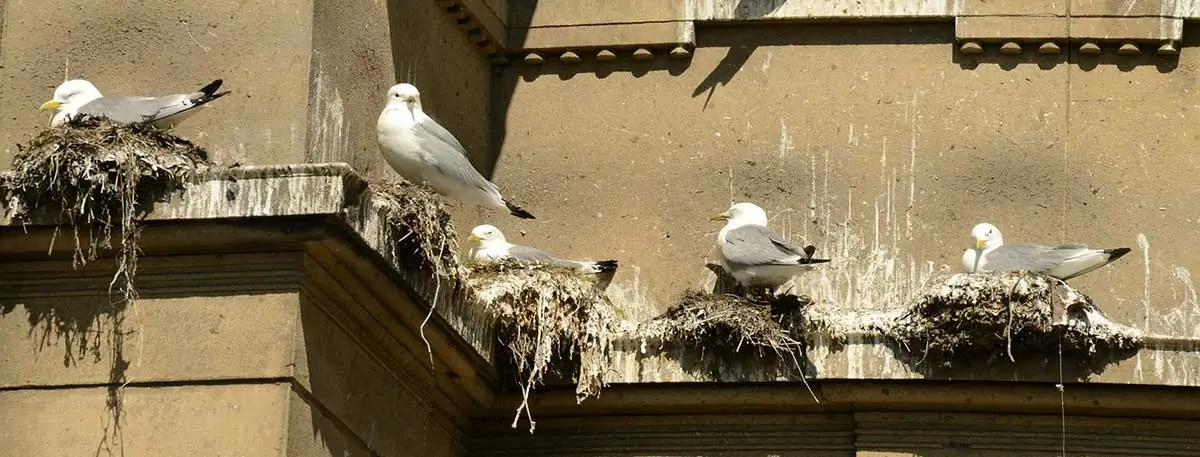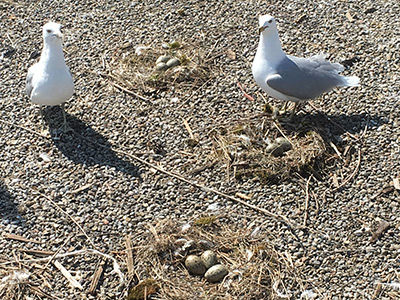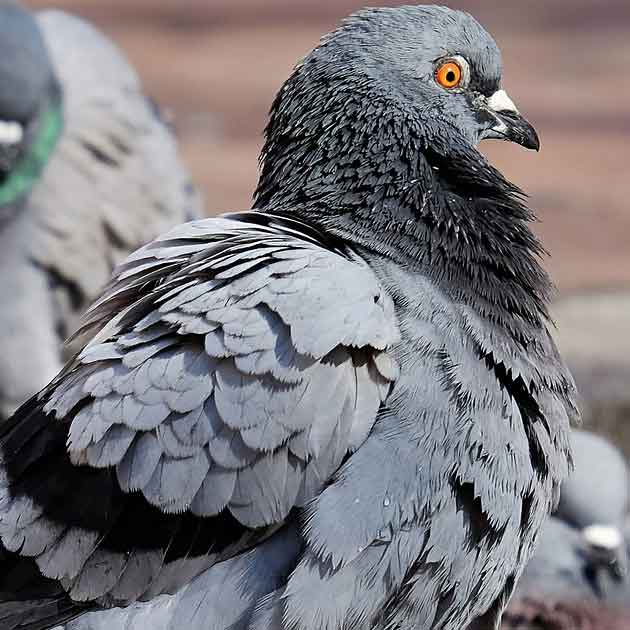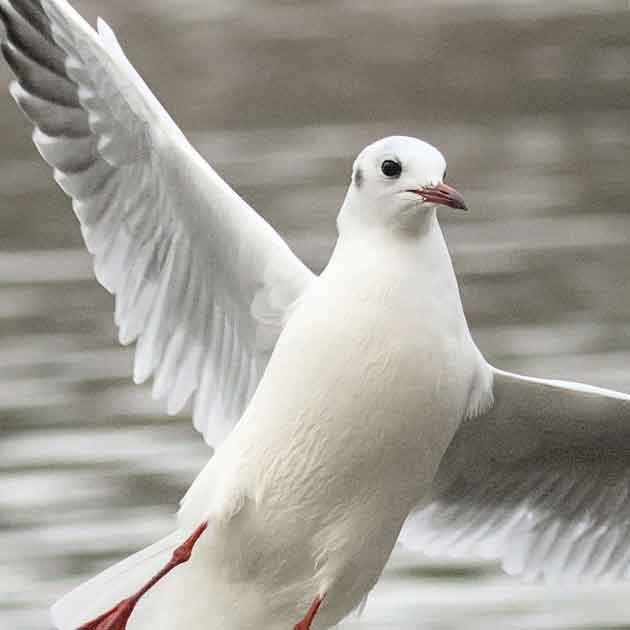In this article, we'll look at where and why you may find seagulls nesting on your property, along with some suggestions when you do. Summary:
Where do Seagulls Build Their Nests?
- Seagulls prefer nesting on flat gravel covered roofs.
- Seagulls prefer to build nests beside pipes or low structures on the roof to protect the nests.
- Seagulls are protected wildlife in Canada and the USA. Permits can take up to 3 weeks to obtain. In Southern Ontario, Hawkeye starts permit applications in January and February.

Seagulls generally live within sight of water. They can be found near oceans, rivers, inland waterways, lakes, and even ponds. Gulls are scavengers and will eat almost any food they come across, including fish, crustaceans, worms, mollusks, berries, etc. They will eat leftovers from people food, too. That is why they are often found in parks and on beaches where people will have picnics and snacks. Unfortunately, people have been known to throw their leftover scraps to the seagulls. This has been made illegal in many areas as it can lead to dangerous episodes of children and pets being dive-bombed by gulls looking for food. The seagulls have come to associate people with food and expect to be fed when they see people. Eating human food can cause illness in the birds as most foods people throw to the birds are not nutritious enough they will fill up with nutrient deficient food.
Seagulls are highly adaptable and have learned to live alongside humans and thrive. They frequently choose man made structures for building their nests, as it affords more protection than to build closer to the ground. The roofs of large buildings tend to be highly favoured due to the construction of the roof - often flat and with stones on it. The stones almost invite them as they resemble beaches and cliffs. Unfortunately, this preference can cause problems for the owners of the structures and the people who live or work in them.
Where do Seagulls tend to build their nests?
They are not too picky about where they choose to nest, focusing on proximity to food, water, and safety. Their favourite seems to be a warehouse sized flat roof with gravel and structures with corners, such as HVAC units or solar panels. Nests are tucked against a ledge or corner for protection and stability. Visibility in all directions (to spot predators) and easy access for landing and take off, is a plus as well.
Why are there SO many Seagull Nests?
Seagulls are highly social creatures and on a large roof they can nest in close proximity for safety and closeness. There is strength in numbers. Colonial nesting allows for increased protection from predators, cooperative defense, and information sharing about dangers or food sources. It isn’t unusual to find more than a thousand nests and a few thousand birds congregated on one large warehouse type roof. You can imagine the noise this many birds can make. Then, double the noise when the eggs hatch and there are fledglings running all over the roof. New issues arise when those little ones fall off the ledge and end up in a parking lot below.

What do Seagull Nests look like?
Seagull nests may contain straw, grasses, twigs, and almost anything the birds can find including made made materials like plastic, paper, cloth. Sometimes the nests are barely there and they scoop away gravel to make a depression and add a few nesting materials before they lay their eggs, usually 2 to 3 eggs. If the food supply nearby is very generous they may be up to 4 or even 5 eggs in a nest, although this is rare.
The ugly side of Nesting Seagulls
- The mess they make with roosting, nesting and nesting materials all over the roof, and of course, the bird droppings can cause extensive damage to the roof of the buildings. Structural damage occurs from the acidity of the bird dropping and can actually rot the roof in spots, causing severe leaks. There have been instances where parts of the roof has collapsed and fallen to the floor beneath it.
- The accumulation of droppings and nesting materials, not to mention the feathers all over, pose substantial health risks, as birds, their feathers and their droppings can and usually do carry bacteria, virus and fungal infections that are easily transmissible to humans.
- Many times the birds and their nests are near or under HVAC units on the roof and the air that is carried inside from the unit is blowing the pathogens inside the building putting people at risk of inhaling these pathogens.
- Gulls can be very noisy, their raucous bird calls can become very annoying, especially when you are hearing hundreds or thousands of seagulls. The noise and disturbance of the birds can be very disruptive for the inhabitants or the workers in these buildings.
- Cars parked nearby will have droppings on them that can cause paint damage.
- The birds may harass people walking to and from theirs cars outside the buildings, especially when the fledglings have hatched and the seagulls or more protective.
Addressing the issue of seagulls nesting on any roof in Canada will require a permit from Canadian Wildlife Services of the Federal Government. To remove birds and/or nests, you require permission. Once fledglings have hatched, that permission is very difficult to get, as seagulls are protected wildlife. Once a permit is issued, you will have limits on the number of eggs and nests you are allowed to pick up. If the number on the roof exceeds the number on the permit you will have to have the number amended by the Canadian Wildlife Services.
How do I prevent Seagulls from Nesting?
- To prevent seagulls from congregating and nesting you can put in physical barriers such as netting or bird spikes to prevent the seagulls from landing. Netting, or any of the ledge protection systems need to be professionally installed to make sure they are effective and don’t cause the birds any harm.
- Visual and Auditory deterrents may be effective in the short term only. Seagulls tend to get used to the noise of any noisemaker fairly quickly. Visual deterrents may work a little longer. A reflective object that blows in the wind or a decoy such as a fake bird of prey - one that moves around - can temporarily deter seagulls from approaching potential nesting areas.
- Changing the structure of the roof may also be of some use - remove any gravel or change the angle of a flat roof, to deter birds from nesting.
- Secure any garbage bins or remove any visible and accessible food waste as that is what makes a nesting area attractive to a seagull.
Hawkeye Bird & Animal Control to the Rescue
As with any Bird Control issue - once you actually have an issue - please call the professionals in to deal with it. A professional will know the permit requirements necessary and will help you obtain such permit(s). Call Hawkeye Bird and Animal Control. We know the the rules and regulations of the Canadian Wildlife Service and the Ministry of Natural Resources and Forestry. We can answer any of your questions and take care of any of your bird issues.














